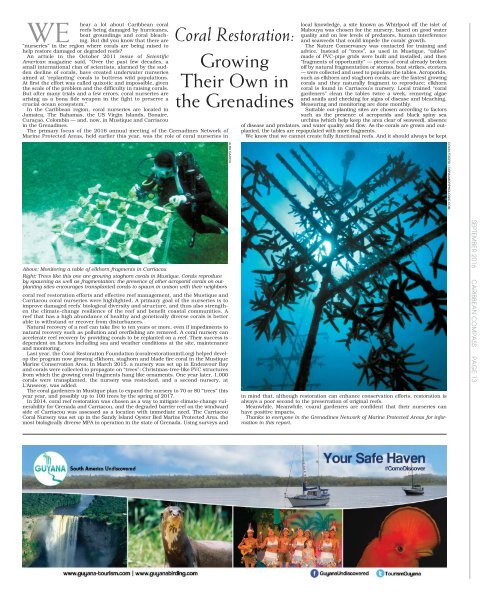Caribbean Compass Yachting Magazine September 2016
Welcome to Caribbean Compass, the most widely-read boating publication in the Caribbean! THE MOST NEWS YOU CAN USE - feature articles on cruising destinations, regattas, environment, events...
Welcome to Caribbean Compass, the most widely-read boating publication in the Caribbean! THE MOST NEWS YOU CAN USE - feature articles on cruising destinations, regattas, environment, events...
Create successful ePaper yourself
Turn your PDF publications into a flip-book with our unique Google optimized e-Paper software.
WE<br />
hear a lot about <strong>Caribbean</strong> coral<br />
reefs being damaged by hurricanes,<br />
boat groundings and coral bleaching.<br />
But did you know that there are<br />
“nurseries” in the region where corals are being raised to<br />
help restore damaged or degraded reefs?<br />
An article in the October 2011 issue of Scientific<br />
American magazine said, “Over the past few decades, a<br />
small international clan of scientists, alarmed by the sudden<br />
decline of corals, have created underwater nurseries<br />
aimed at ‘replanting’ corals to buttress wild populations.<br />
At first the effort was called quixotic and impossible, given<br />
the scale of the problem and the difficulty in raising corals.<br />
But after many trials and a few errors, coral nurseries are<br />
arising as a bona fide weapon in the fight to preserve a<br />
crucial ocean ecosystem.”<br />
In the <strong>Caribbean</strong> region, coral nurseries are located in<br />
Jamaica, The Bahamas, the US Virgin Islands, Bonaire,<br />
Curaçao, Colombia — and, now, in Mustique and Carriacou<br />
in the Grenadines.<br />
The primary focus of the <strong>2016</strong> annual meeting of the Grenadines Network of<br />
Marine Protected Areas, held earlier this year, was the role of coral nurseries in<br />
Coral Restoration:<br />
Growing<br />
Their Own in<br />
the Grenadines<br />
local knowledge, a site known as Whirlpool off the islet of<br />
Mabouya was chosen for the nursery, based on good water<br />
quality and on low levels of predators, human interference<br />
and seaweeds that could impede the corals’ growth.<br />
The Nature Conservancy was contacted for training and<br />
advice. Instead of “trees”, as used in Mustique, “tables”<br />
made of PVC-pipe grids were built and installed, and then<br />
“fragments of opportunity” — pieces of coral already broken<br />
off by natural fragmentation or storms, boat strikes, etcetera<br />
— were collected and used to populate the tables. Acroporids,<br />
such as elkhorn and staghorn corals, are the fastest growing<br />
corals and they naturally fragment to reproduce; elkhorn<br />
coral is found in Carriacou’s nursery. Local trained “coral<br />
gardeners” clean the tables twice a week, removing algae<br />
and snails and checking for signs of disease and bleaching.<br />
Measuring and monitoring are done monthly.<br />
Suitable out-planting sites are chosen according to factors<br />
such as the presence of acroporids and black spiny sea<br />
urchins (which help keep the area clear of seaweed), absence<br />
of disease and predators, and water quality and flow. As the corals are grown and outplanted,<br />
the tables are repopulated with more fragments.<br />
We know that we cannot create fully functional reefs. And it should always be kept<br />
COLIN FOORD / CORALMORPHOLOGIC.COM<br />
ALBA GARCIA<br />
Above: Monitoring a table of elkhorn fragments in Carriacou<br />
Right: Trees like this one are growing staghorn corals in Mustique. Corals reproduce<br />
by spawning as well as fragmentation; the presence of other acroporid corals on outplanting<br />
sites encourages transplanted corals to spawn in unison with their neighbors<br />
coral reef restoration efforts and effective reef management, and the Mustique and<br />
Carriacou coral nurseries were highlighted. A primary goal of the nurseries is to<br />
improve damaged reefs’ biological diversity and structure, and thus also strengthen<br />
the climate-change resilience of the reef and benefit coastal communities. A<br />
reef that has a high abundance of healthy and genetically diverse corals is better<br />
able to withstand or recover from disturbances.<br />
Natural recovery of a reef can take five to ten years or more, even if impediments to<br />
natural recovery such as pollution and overfishing are removed. A coral nursery can<br />
accelerate reef recovery by providing corals to be replanted on a reef. Their success is<br />
dependent on factors including sea and weather conditions at the site, maintenance<br />
and monitoring.<br />
Last year, the Coral Restoration Foundation (coralrestorationintl.org) helped develop<br />
the program now growing elkhorn, staghorn and blade fire coral in the Mustique<br />
Marine Conservation Area. In March 2015, a nursery was set up in Endeavour Bay<br />
and corals were collected to propagate on “trees”: Christmas-tree-like PVC structures<br />
from which the growing coral fragments hang like ornaments. One year later, 1,000<br />
corals were transplanted, the nursery was restocked, and a second nursery, at<br />
L’Ansecoy, was added.<br />
The coral gardeners in Mustique plan to expand the nursery to 70 or 80 “trees” this<br />
year year, and possibly up to 100 trees by the spring of 2017.<br />
In 2014, coral reef restoration was chosen as a way to mitigate climate-change vulnerability<br />
for Grenada and Carriacou, and the degraded barrier reef on the windward<br />
side of Carriacou was assessed as a location with immediate need. The Carriacou<br />
Coral Nursery was set up in the Sandy Island Oyster Bed Marine Protected Area, the<br />
most biologically diverse MPA in operation in the state of Grenada. Using surveys and<br />
in mind that, although restoration can enhance conservation efforts, restoration is<br />
always a poor second to the preservation of original reefs.<br />
Meanwhile, Meanwhile, coaral gardeners are confident that their nurseries can<br />
have positive impacts.<br />
Thanks to everyone in the Grenadines Network of Marine Protected Areas for information<br />
in this report.<br />
SEPTEMBER <strong>2016</strong> CARIBBEAN COMPASS PAGE 13


















